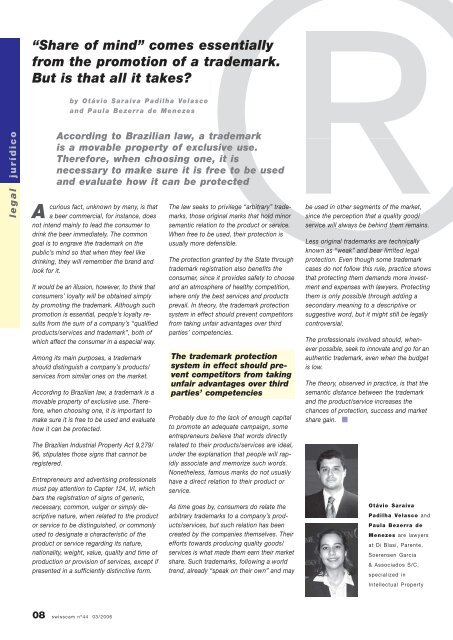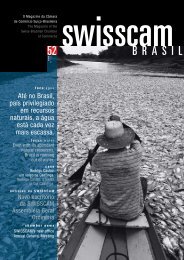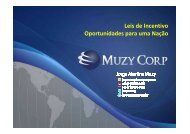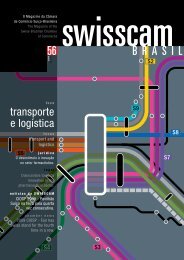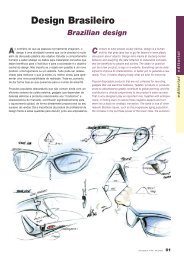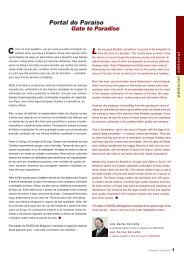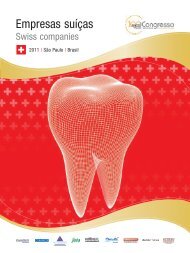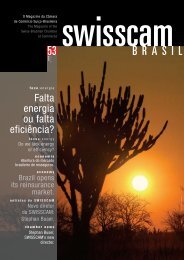01 Logística e Infra-estrutura no Brasil – Desafios e ... - Swisscam
01 Logística e Infra-estrutura no Brasil – Desafios e ... - Swisscam
01 Logística e Infra-estrutura no Brasil – Desafios e ... - Swisscam
You also want an ePaper? Increase the reach of your titles
YUMPU automatically turns print PDFs into web optimized ePapers that Google loves.
“Share of mind” comes essentially<br />
from the promotion of a trademark.<br />
But is that all it takes?<br />
by Otávio Saraiva Padilha Velasco<br />
and Paula Bezerra de Menezes<br />
jurídico<br />
legal<br />
A<br />
According to Brazilian law, a trademark<br />
is a movable property of exclusive use.<br />
Therefore, when choosing one, it is<br />
necessary to make sure it is free to be used<br />
and evaluate how it can be protected<br />
curious fact, unk<strong>no</strong>wn by many, is that<br />
a beer commercial, for instance, does<br />
<strong>no</strong>t intend mainly to lead the consumer to<br />
drink the beer immediately. The common<br />
goal is to engrave the trademark on the<br />
public’s mind so that when they feel like<br />
drinking, they will remember the brand and<br />
look for it.<br />
It would be an illusion, however, to think that<br />
consumers’ loyalty will be obtained simply<br />
by promoting the trademark. Although such<br />
promotion is essential, people’s loyalty results<br />
from the sum of a company’s “qualified<br />
products/services and trademark”, both of<br />
which affect the consumer in a especial way.<br />
Among its main purposes, a trademark<br />
should distinguish a company’s products/<br />
services from similar ones on the market.<br />
According to Brazilian law, a trademark is a<br />
movable property of exclusive use. Therefore,<br />
when choosing one, it is important to<br />
make sure it is free to be used and evaluate<br />
how it can be protected.<br />
The Brazilian Industrial Property Act 9,279/<br />
96, stipulates those signs that can<strong>no</strong>t be<br />
registered.<br />
Entrepreneurs and advertising professionals<br />
must pay attention to Capter 124, VI, which<br />
bars the registration of signs of generic,<br />
necessary, common, vulgar or simply descriptive<br />
nature, when related to the product<br />
or service to be distinguished, or commonly<br />
used to designate a characteristic of the<br />
product or service regarding its nature,<br />
nationality, weight, value, quality and time of<br />
production or provision of services, except if<br />
presented in a sufficiently distinctive form.<br />
The law seeks to privilege “arbitrary” trademarks,<br />
those original marks that hold mi<strong>no</strong>r<br />
semantic relation to the product or service.<br />
When free to be used, their protection is<br />
usually more defensible.<br />
The protection granted by the State through<br />
trademark registration also benefits the<br />
consumer, since it provides safety to choose<br />
and an atmosphere of healthy competition,<br />
where only the best services and products<br />
prevail. In theory, the trademark protection<br />
system in effect should prevent competitors<br />
from taking unfair advantages over third<br />
parties’ competencies.<br />
The trademark protection<br />
system in effect should prevent<br />
competitors from taking<br />
unfair advantages over third<br />
parties’ competencies<br />
Probably due to the lack of e<strong>no</strong>ugh capital<br />
to promote an adequate campaign, some<br />
entrepreneurs believe that words directly<br />
related to their products/services are ideal,<br />
under the explanation that people will rapidly<br />
associate and memorize such words.<br />
Nonetheless, famous marks do <strong>no</strong>t usually<br />
have a direct relation to their product or<br />
service.<br />
As time goes by, consumers do relate the<br />
arbitrary trademarks to a company’s products/services,<br />
but such relation has been<br />
created by the companies themselves. Their<br />
efforts towards producing quality goods/<br />
services is what made them earn their market<br />
share. Such trademarks, following a world<br />
trend, already “speak on their own” and may<br />
be used in other segments of the market,<br />
since the perception that a quality good/<br />
service will always be behind them remains.<br />
Less original trademarks are technically<br />
k<strong>no</strong>wn as “weak” and bear limited legal<br />
protection. Even though some trademark<br />
cases do <strong>no</strong>t follow this rule, practice shows<br />
that protecting them demands more investment<br />
and expenses with lawyers. Protecting<br />
them is only possible through adding a<br />
secondary meaning to a descriptive or<br />
suggestive word, but it might still be legally<br />
controversial.<br />
The professionals involved should, whenever<br />
possible, seek to in<strong>no</strong>vate and go for an<br />
authentic trademark, even when the budget<br />
is low.<br />
The theory, observed in practice, is that the<br />
semantic distance between the trademark<br />
and the product/service increases the<br />
chances of protection, success and market<br />
share gain.<br />
Otávio Saraiva<br />
Padilha Velasco and<br />
Paula Bezerra de<br />
Menezes are lawyers<br />
at Di Blasi, Parente,<br />
Soerensen Garcia<br />
& Associados S/C,<br />
specialized in<br />
Intellectual Property<br />
08 swisscam nº44 03/2006


